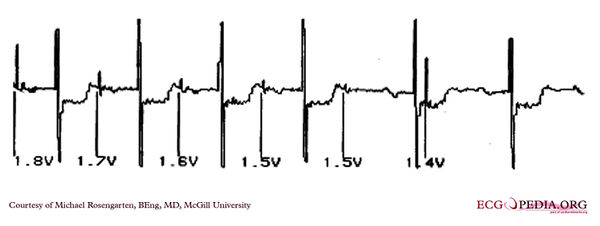McGill Case 146: Difference between revisions
Jump to navigation
Jump to search
Created page with "{{McGillcase| |previouspage= McGill Case 145 |previousname= McGill Case 145 |nextpage= McGill Case 147 |nextname= McGill Case 147 }} thumb|600px|left|." |
No edit summary |
||
| Line 6: | Line 6: | ||
}} | }} | ||
[[File:E0003146.jpg|thumb|600px|left|.]] | [[File:E0003146.jpg|thumb|600px|left|The cardiogram illustrates the determination of the atrial capture threshold. The pacemaker is decrementing down the atrial amplitude as marked below the atrial pacer spikes. note the loss of atrial capture after the second spike of 1.5 volts. Loss of capture is illustrated by three events, 1) the lack of a p wave after the spike, 2) the appearance of a native p wave after the failure to capture and 3) the change in the RR intervals as the QRS is no longer following the paced P wave. The lack of capture after the second 1.5 volt complex illustrates a component of time dependent capture where after a while a stimulus may fail to capture even thought the amplitude is kept constant.]] | ||
Latest revision as of 20:05, 17 February 2012

|
